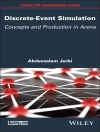This book aims at promoting high-quality research by researchers and practitioners from academia and industry at the International Conference on Computational Intelligence, Cyber Security, and Computational Models ICC3 2015 organized by PSG College of Technology, Coimbatore, India during December 17 – 19, 2015. This book enriches with innovations in broad areas of research like computational modeling, computational intelligence and cyber security. These emerging inter disciplinary research areas have helped to solve multifaceted problems and gained lot of attention in recent years. This encompasses theory and applications, to provide design, analysis and modeling of the aforementioned key areas.
Table des matières
Part I_Keynote Address: 1. The game of Wall Cops and Robbers.- 2. Smartphone Applications, Malware and Data Theft.- 3. Towards Evolutionary Multitasking: A New Paradigm in Evolutionary Computation.- 4. Generating a Standardized Upper Ontology for Security of Information and Networks.- Part II_Computational Intelligence: Chapter 1. Analysis of Throat Microphone Using MFCC features for Speaker Recognition.- Chapter 2. Single-pixel Based Double Random-Phase Encoding Technique.- Chapter 3. Kernel Online Multi-task Learning.- Chapter 4. Performance Evaluation of Sentiment Classification Using Query Strategies in a Pool Based Active Learning Scenario.- Chapter 5. An Enhanced Image Watermarking Scheme Using Blocks with Homogeneous Feature Distribution.- Chapter 6. Performance Analysis of Ap En as a Feature Extraction Technique and Time Delay Neural Networks, Multi-layer Perceptron as Post Classifiers for the Classification of Epilepsy Risk Levels from EEG Signals.- Chapter 7. Suspicious Human Activity Detection in Classroom Examination.- Chapter 8. H ∞ State Estimation of Discrete Time Delayed Neural Networks with Multiple Missing Measurements Using Second Order Reciprocal Convex Approach.- Chapter 9. A Fuzzy Methodology for Clustering Text Documents with Uncertain Spatial References.- Chapter 10. A Novel Feature Extraction Algorithm from Fingerprint Image in Wavelet Domain.- Chapter 11. Motor imagery Classification Based on Variable Precision Multigranulation Rough Set.- Chapter 12. Fault Tolerant and Energy Efficient Signal Processing on FPGA Using Evolutionary Techniques.- Chapter 13. A Two Phase Approach for Efficient Clustering of Web Services.- Chapter 14. Elimination of Redundant Association Rules – An Efficient Linear Approach.- Chapter 15. Clustering Techniques from Significance Analysis of Microarrays.- Chapter 16. Breast Region Extraction and Pectoral Removal by Pixel Constancy Constraint approach in Mammograms.- Chapter 17. Bridging the Semantic Gap in Image Search via Visual Semantic Descriptors by Integrating Text and Visual Features.- Chapter 18. Adaptive Equalization Algorithm for Electrocardiogram Signal Transmission.- Chapter 19. An Efficient Approach for Map Reduce Result Verification.- Chapter 20. Improving Lifetime of Memory Devices Using Evolutionary Computing Based Error Correction Coding.- Chapter 21. Comparison of Machine Learning Techniques for the Identification of the Stages of Parkinson’s Disease.- Chapter 22. Security Constrained Unit Commitment Problem Employing Artificial Computational Intelligence for Wind-thermal Power System.- Chapter 23. Human Gait Recognition Using Fuzzy Logic.- Chapter 24. Detection and Diagnosis of Dilated and Hypertrophic Cardiomyopathy by Echocardiogram Sequences Analysis.- Chapter 25. An Elitist Genetic Algorithm Based Extreme Learning Machine.- Chapter 26. Formulation and Enhancement of User Adaptive Access to the Learning Resources in E-Learning Using Fuzzy Inference Engine.- Part III_Cyber Security: Chapter 27. A Robust User Anonymity Preserving Biometric Based Multi-server Authenticated Key Agreement Scheme.- Chapter 28. Extended Game Theoretic Dirichlet Based Collaborative Intrusion Detection Systems.- Chapter 29. Implementation of ECDSA Using Sponge Based Hash Function.- Chapter 30. Contrast-Enhanced Visual Cryptography Schemes Based on Perfect Reconstruction of White Pixels and Additional Basis Matrix.- Chapter 31. Hash Based Two Gateway Payment Protocol Ensuring Accountability with Dynamic ID-verifier for Digital Goods Providers.- Chapter 32. Decrypting Shared Encrypted Data Files Stored in a Cloud Using Dynamic Key Aggregation.- Chapter 33. A Lock and Key Share (2, m, n) Random Grid Visual Secret Sharing Scheme with XOR and OR Decryptions.- Chapter 34. Multilevel Multimedia Security by Integrating Visual Cryptography and Steganography Techniques.- Chapter 35. K out of N Secret Sharing Scheme with Steganography and Authentication.- Chapter 36. A Centralized Trust Computation Model (CTC) for Secure Group Formation in Military Based Mobile Ad-hoc Networks Using Stereotypes.- Chapter 37. Cost Effective Re-keying Approach for Dynamic Membership Changes in Group Key Management.- Chapter 38. A Multipath Routing Protocol which Preserves Security and Anonymity of Data in Mobile Ad-hoc Networks.- Chapter 39. An Efficient Continuous Auditing Methodology for Outsourced Data Storage in Cloud Computing.- Part IV_Computational Models: Chapter 40. A Study on Building Seamless Communication Among Vehicles in Vanet Using the Integrated Agent Communication Model (IACM).- Chapter 41. A Hybrid Approach for Data Hiding through Chaos Theory and Reversible Integer Mapping.- Chapter 42. Fluid Queue Driven by an M/E2/1 Queuing Model.- Chapter 43. An Effective Tool for optimizing the Number of Test Paths in Data Flow Testing for Anomaly Detection.- Chapter 44. Venus Flytrap Optimization.- Chapter 45. Zumkeller Cordial Labeling of Graphs.- Chapter 46. Cuckoo Based Resource Allocation for Mobile Cloud Environments.- Chapter 47. Transient Analysis of an M/M/c Queue Subject to Multiple Exponential Vacation.- Chapter 48. Fractional Filter Based Internal Model Controller for Nonlinear Process.- Chapter 49. A Novel Method for Solving Triangular and Trapezoidal Intuitionistic Fuzzy Games Using Dominance Property and Oddment Method.
A propos de l’auteur
Muthukrishnan Senthilkumar is an Associate Professor, Department of Applied Mathematics and Computational Sciences, PSG College of Technology. He has got Post Doctoral Fellowship from Department of Nanobio Materials and Electronics, (WCU), Gwangju Institute of Science and Technology (GIST), Gwangju, Republic of Korea. He is also a Visiting Professor to the School of Information and Communication, GIST, Republic of Korea. He has over 16 years of teaching and research experience. He has received Ph D in Retrial Queueing Models from Anna University, Chennai, India. His biography is recognized and included in the biographies of Marquis Who’s Who in the World 2013 and 2016. His fields of interest include retrial queueing theory, data communication and reliability engineering. He has published several research articles in refereed reputed journals. Currently he is guiding 4 Ph D scholars.
Vijayalakshmi Ramasamy has over 19 years of academic experience and currently is Associate Professor in the Department of Applied Mathematics and Computational Sciences at PSG College of Technology, India. She received her Ph D in Graph Mining Algorithms from Anna University. Her research interest includes graph based data mining, especially complex network systems, and social network analysis. Her research publications include about 30 Peer reviewed International Journals and conference papers. She has been a reviewer in reputed journals. She is currently actively associated with Cognitive Neuro-engineering Laboratory (CNEL), Uni SA in the acquisition and analysis of brain wave data for cognitive modeling, pattern identification and visualization using graph-theoretic approaches. She has established a Computational Neuroscience Laboratory in 2012 at PSG College of Technology in association with Prof. Nanda Nandagopal, Professor of Defense, University of South Australia, Australia.
Shina Sheen is an Assistant Professor (Selection Grade) at the Department of Applied Mathematics and Computational Sciences at PSG College of Technology. She holds a BSc in Physics from Calicut University and a MCA and MPhil in Computer Science from Bharathiyar University. Her Ph D thesis is in the area of Malware Detection using Machine Learning and Data Mining Techniques. Her research focuses on security in smart devices, intrusion detection, Cyber security and Data Mining. She has published articles in refereed reputed journals and conference proceedings. She holds the GIAC certified Intrusion Analyst (GCIA) security certification. She is a member of ACM, Cryptology Research Society of India and the Computer Society of India.
C. Veeramani is an Assistant Professor, Department of Applied Mathematics and Computational Sciences, PSG College of Technology. He has received Ph D degree in Fuzzy Optimization from Anna University, Chennai, India. He has over 10 years of teaching and research experience. His fields of interest include fuzzy optimization, fuzzy logic, soft computing and epidemic models. He has published his research articles in various reputed international journals and international conference proceedings. Currently, he is guiding 4 Ph D scholars in the area of fuzzy optimization and fuzzy epidemic models.
Anthony Bonato is Associate Dean, Students and Programs in the Yeates School of Graduate Studies at Ryerson University and Editor-in-Chief of the journal Internet Mathematics. He has authored over 90 publications with 40 co-authors on the topics of graph theory and complex networks. In 2009 and 2011, he was awarded Ryerson Faculty SRC Awards for excellence in research. In 2012, he was awarded an inaugural YSGS Outstanding Contribution to Graduate Education Award. In 2015, Bonato was appointed to the NSERC Discovery Mathematics and Statistics Evaluation Group for a three year term.
Lynn Batten is the Director of Information Security Group, Deakin University, Australia. Her current research interests include malicious software, information security and reliability, cryptology, computer forensics, coding theory, optimization techniques. She is a member of the editorial board of the Journal of Combinatorial Mathematics and Combinatorial Computing and of the Journal of the Australian Mathematical Society. She is on the Board of Directors of SECIA. She has published several books and research articles in refereed reputed journals.












